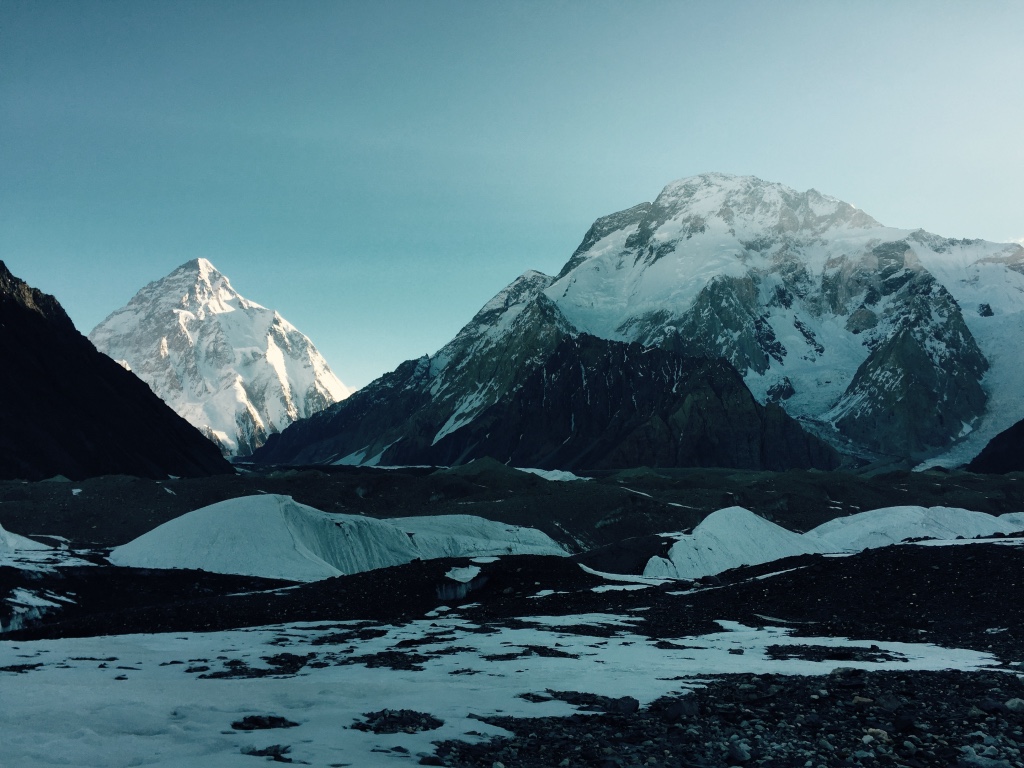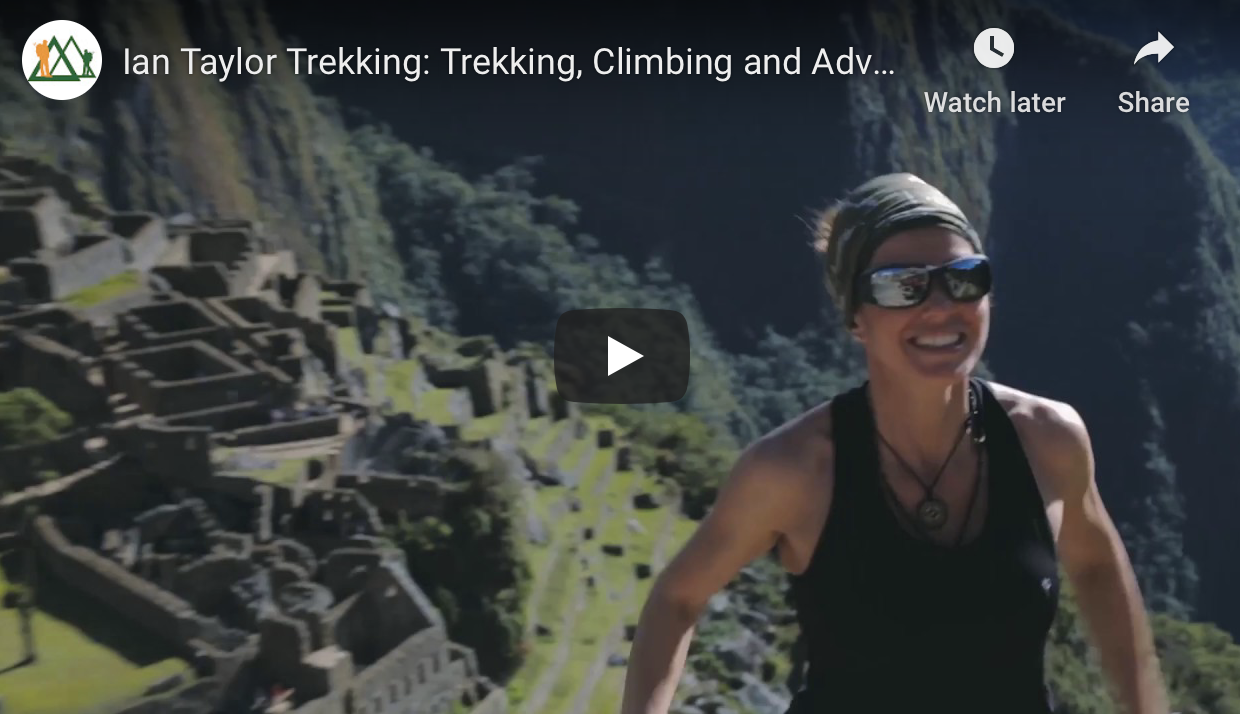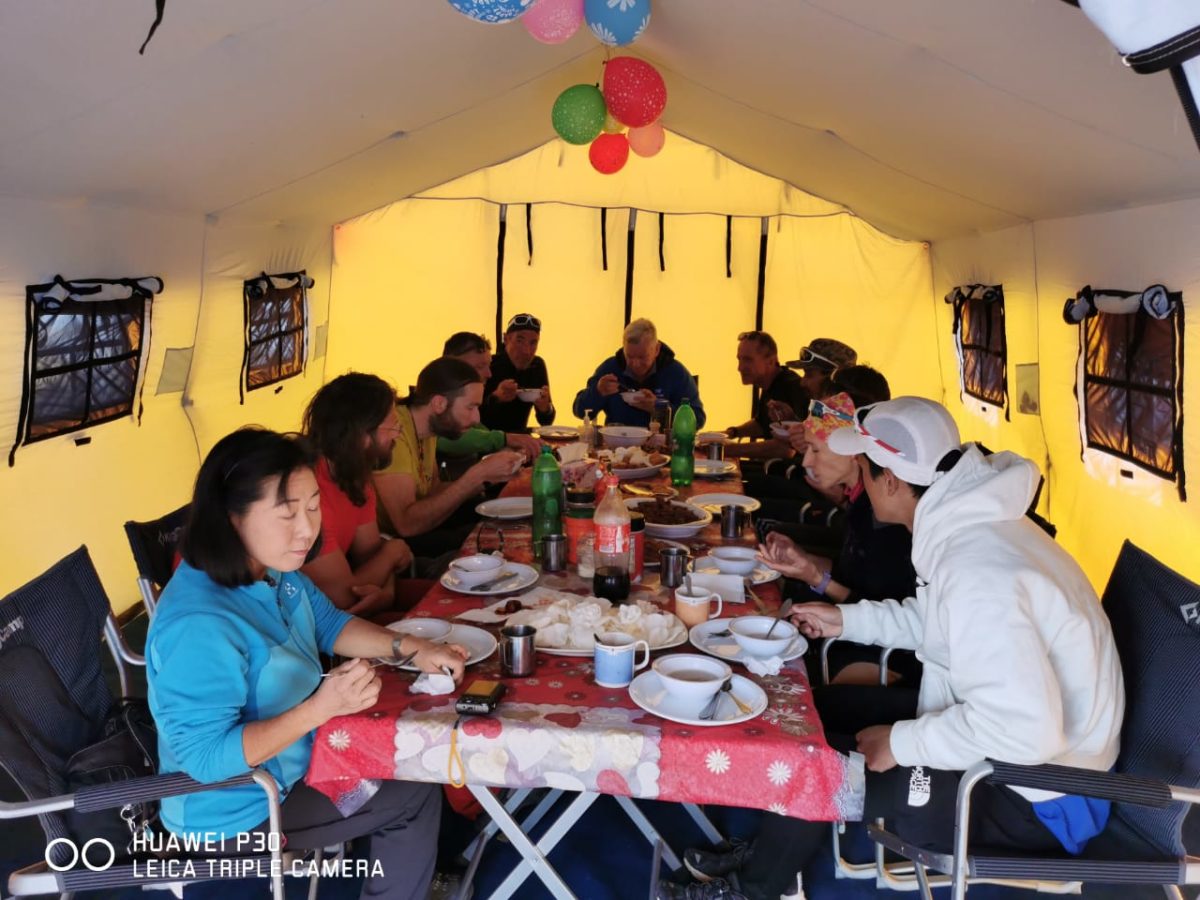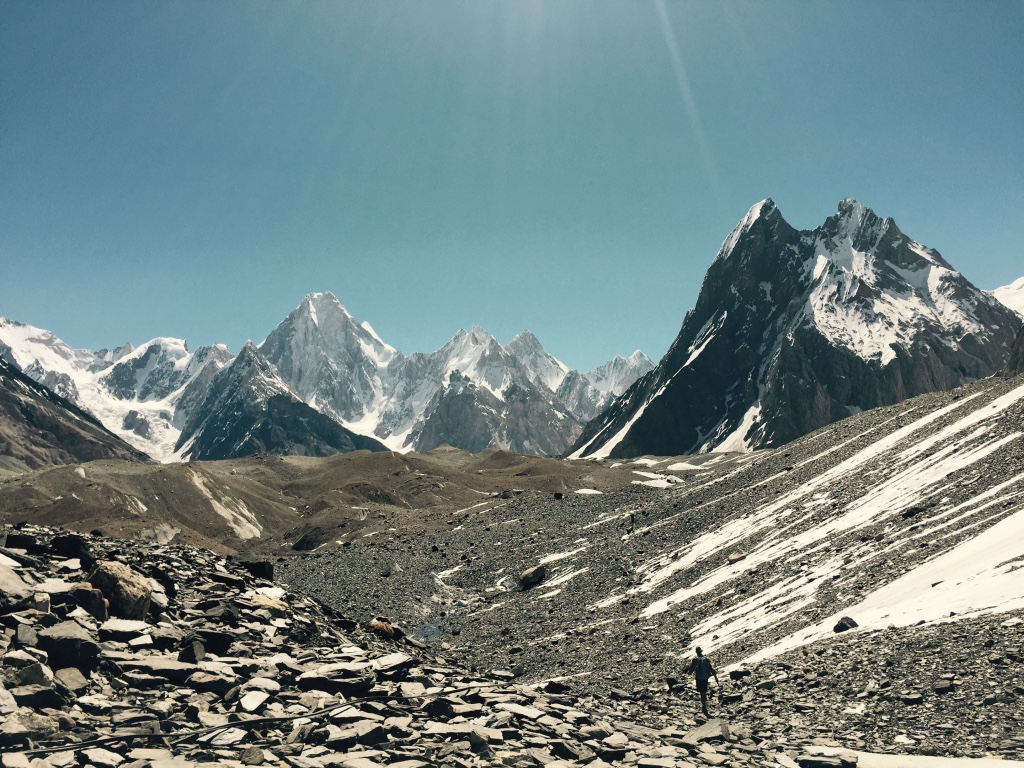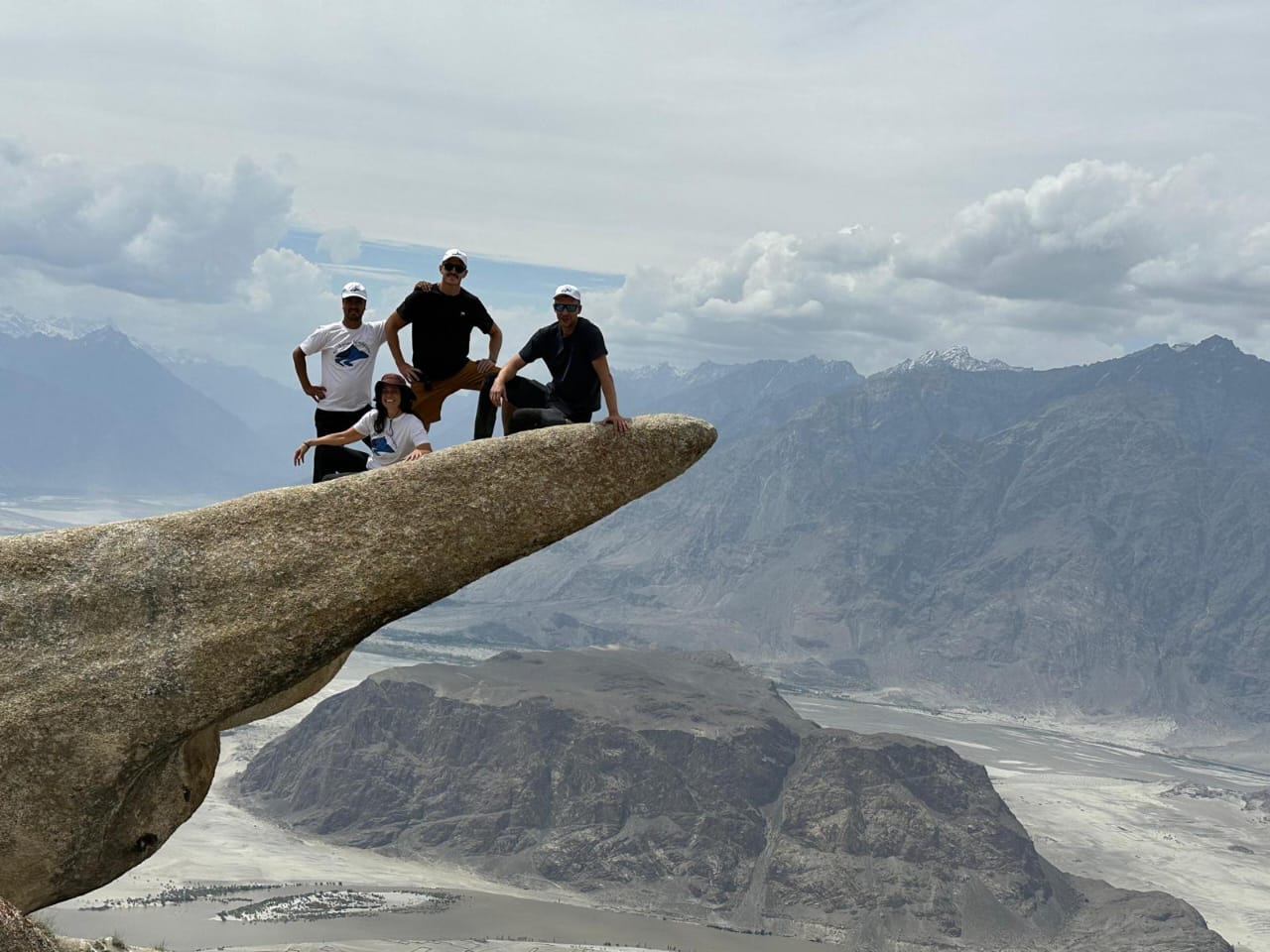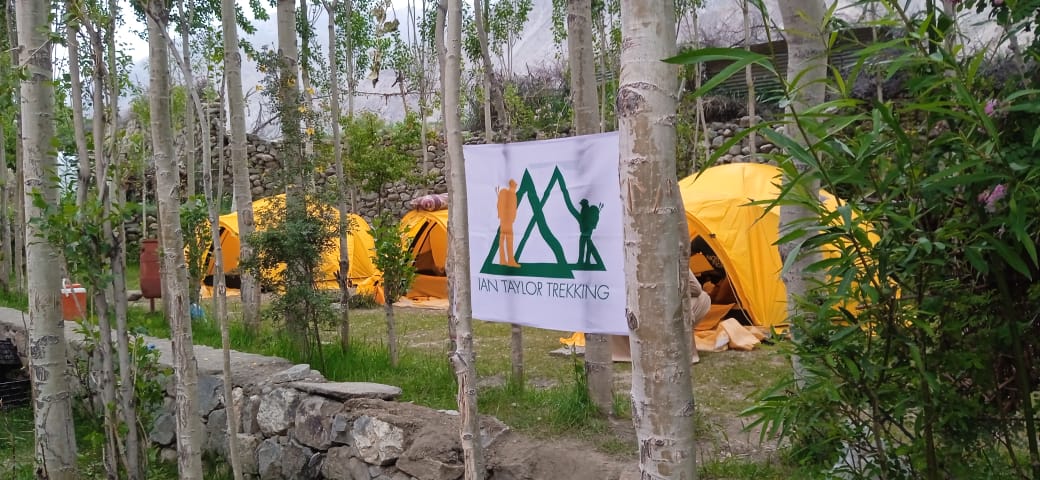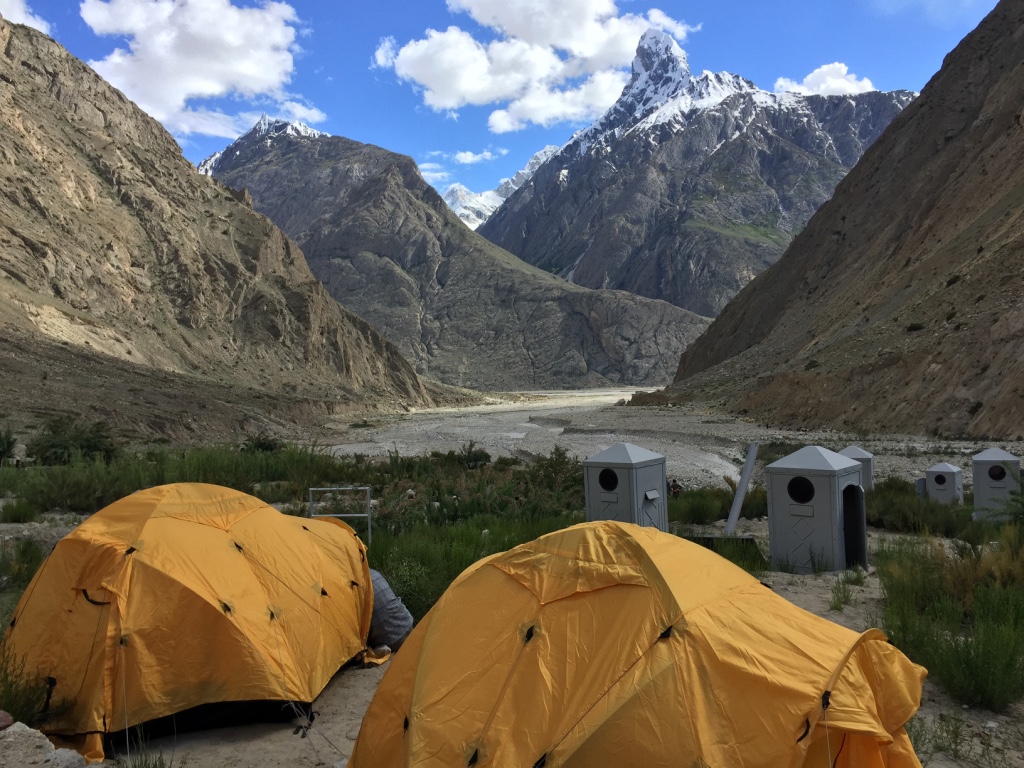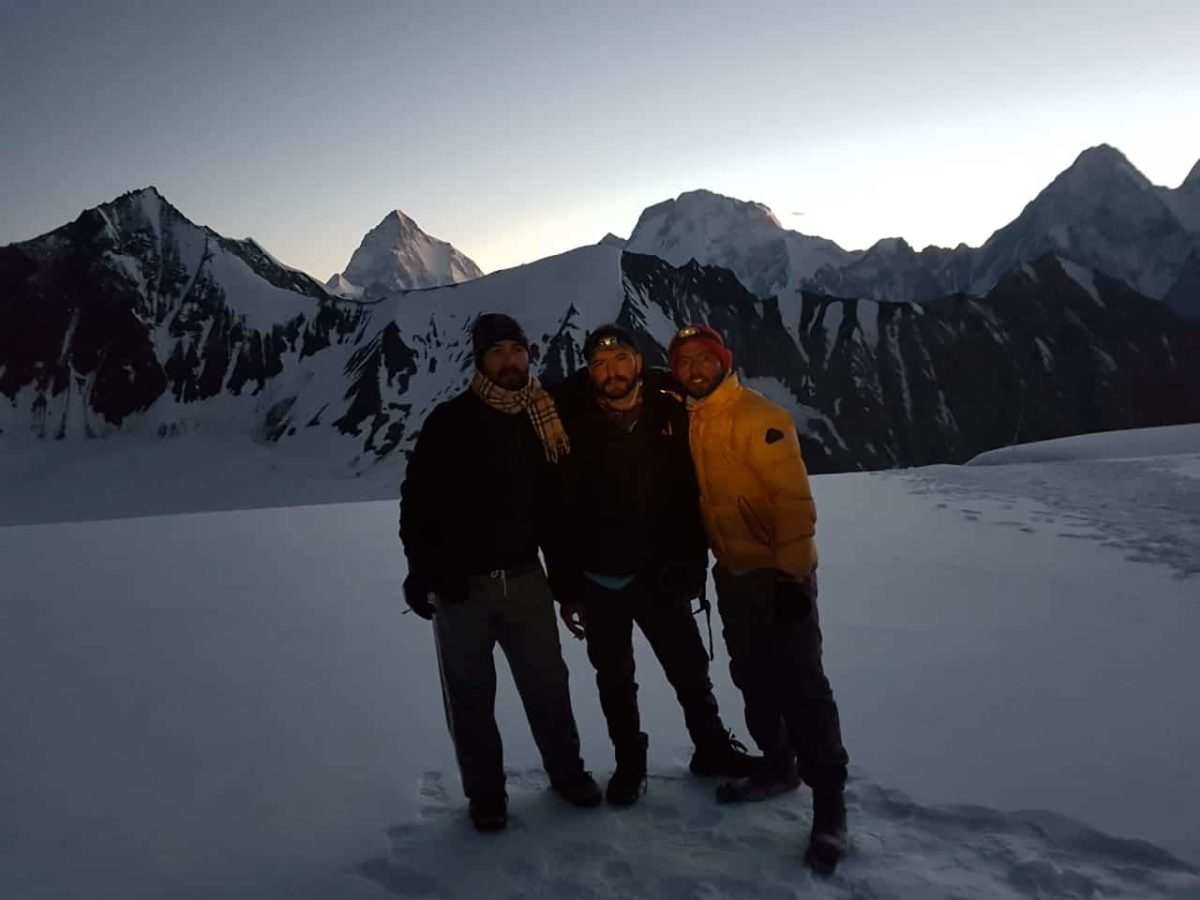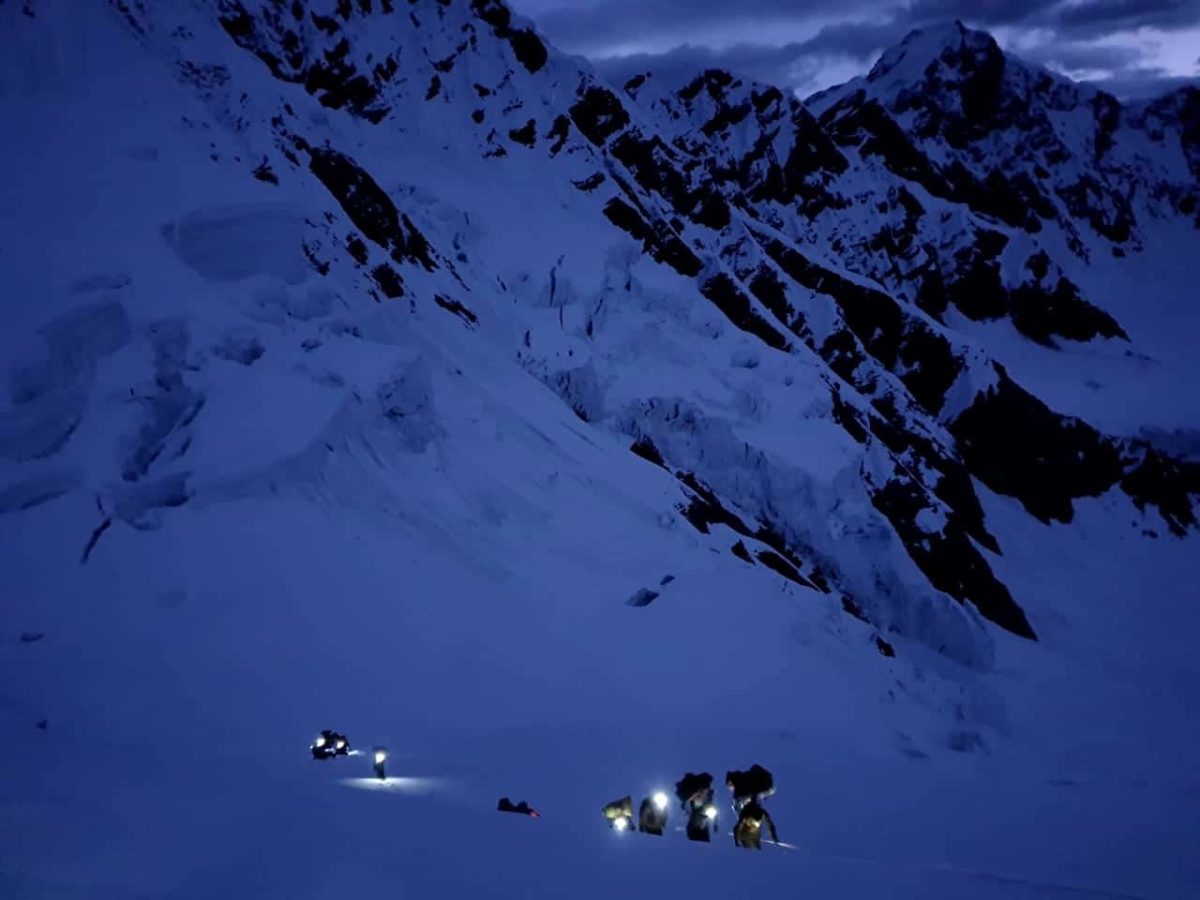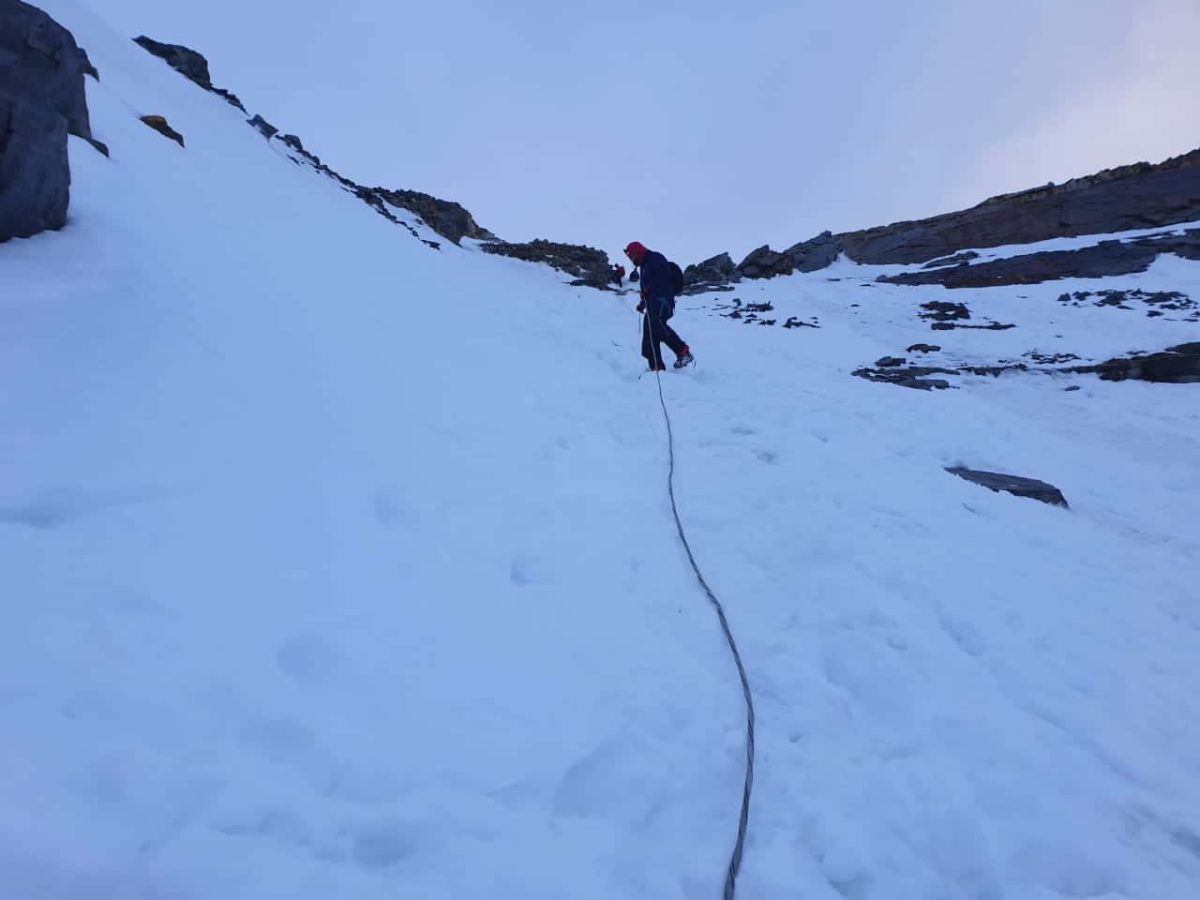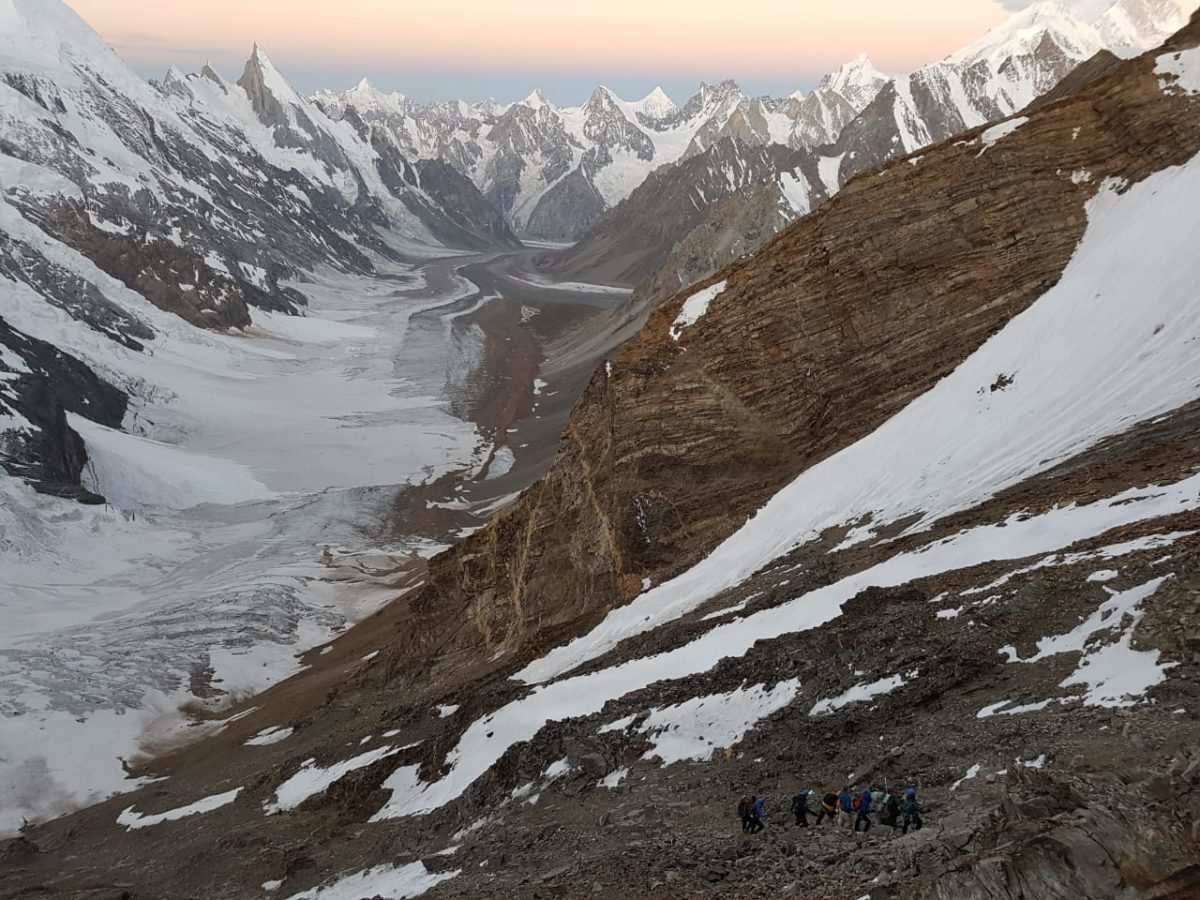K2 Base Camp Treks
We only run quality run trips to K2. Our route through the Concordia up the Baltoro Glacier starts in Islamabad with flight into Skardu, then the long strenuous trek up past Broad Peak to K2 Base Camp where we spend a night, allowing time to absorb the unique atmosphere and environment surrounding this unforgettable mountain. Our return trek takes us the same route unless we try little harder route to go over the spectacular Gondogoro La, a dramatic high col that affords further stunning views of the Gasherbrum peaks. We purposefully cross this pass in the early hours of the morning so, given good weather, we are rewarded with tremendous golden sunshine in one of the most dramatic places on earth. We also have an alternative itinerary to K2 that does not cross the Gondogoro pass. Trips start from USD $5,250
Tips and Advice
1). Have the Right Physical Training
You need to be physically fit and strong for multi-day hiking in a low oxygen environment. The K2 Base Camp Trek should not be your first trekking experience. We only recommend that hikers and trekkers attempt this trek to K2.
2). You Need to Comfortable in the Wilderness
You need excellent Mental strength. Being adaptable, flexible, resilient and comfortable at altitude. You do need to be comfortable in an outdoor environment. Make sure you have being training and preparing correctly. There may be a scenario that requires you to cover more distances and do more while in this environment. Simply put, do not do the bare minimum as you prepare for a trip like this.
3). Make Sure you Have the Right Gear
Adventure know how, making sure you have the right clothing, gear and equipment for all eventualities. You will experience a wide range to weather conditions on a trek to K2 so you need to follow our itemized kit list. We send out our Kit List on signing up to one of our treks.
4). Be Read for Camping
You need to be ready to over come challenges while camping, trekking and moving in a wilderness environment. You will experience good and bad days but important in a team and group environment to work as a team and stay positive during the trip.
5). Plan Well in Advance
It is really important to be planning your trip well in advance. All planning should be done 6+ months prior to departure to Pakistan. We have people planning a year or longer for a trek like this. We can not take any last minute bookings.
6). Have all the Correct Documents
Check all your documents. Your passport must be valid and correct, your visa needs to be in place and you need make sure insurance cover, evacuation cover and flights are all correct well before leaving for Pakistan.
7). Understand all aspects of the Trip
All information regarding the trip should be understood. Read all our information very carefully and prepare accordingly for what each day will bring.
8). Do you Have Your Visa
All ground arrangements, full trip, visa, hotels should be sorted well in advance. If you are booking additional nights hotel this will need to be booked and paid for in advance of your K2 Trek.
9). Make Sure you Trek With Professionals
Of course we will say this, but you should only go with a professional organisation. Having back up logistics, years of managing trips, local government connections and back up support are needed to make sure your trek and trip is managed correctly.
10). This Trek is for Trekkers not Tourists
Make sure you have the specific training needed for this specific trek. This trip is for hikers and trekkers. Having months and years of long distance hiking, training and preparation is important for a trip like K2 Base Camp. LEARN MORE.
11). The Daily Distances on the Trail
Understand the daily trekking distances and elevation gains and losses each day. You need to know so you can make sure you are training in the correct way. We can help you understand the trail, trek and how you should be preparing for your trip.
12). Have Helicopter Evacuation Cover
Make sure you have adequate insurance cover and have Helicopter evacuation cover. This is really important for this trip as you will be long distances away from real medical support. You also need to think about insurance cover, in case on any medical issues. A lot of people consider having trip cancellation cover for Pakistan. The last thing to consider is trip interference cover.
13). Wilderness Medicine
Consider a wilderness medical course and learn more about wilderness medicine. Bring the right medical kit so you can treat minor issue. You also need to bring re-hydration sachets to keep hydrated. Take multivitamins to keep you healthy throughout this long wilderness trip.
14). Manage Your Hygiene
We will prepare clean and quality food throughout the trip. So, you need to manage your personal hygiene at all times. You should be taking multi-vitamins prior and while on the trek to make sure you have a strong immune system throughout this trip.
15). Have Efficient Camp Craft
Make sure your camp craft is efficient and practiced so there are no delays in leaving camp each day. You also want to be comfortable sleeping in a tent. Get out and test your air mattress, sleeping bag, clothing and gear so you know they work.
Get in Touch
When you are planning your training and preparation for your K2 Base Camp Trek you need to consider three things.
1). How much distance you will be hiking each day. You will need to be training for these types of distances on the trail to K2.
2). Consider the elevation gains will you be hiking each day. If you are hiking up and down hills and trails you need to be factoring these into your training.
3). Factor in the lack of oxygen. Training with a weighted backpack will help give you the physical condition needed for the trek.
Where you Start Your Training
When you combine these three factors you can build a training plan for your trek to K2. Below are the daily distances you will be hiking along with the distances. We recommend only hikers and trekkers join this trip. This is not a tourist trek. We also recommend that you are training 4/5 times a week building the time and hours you are training over months of training. We also recommend you build up to carrying double the weight you carry on the trail so building from 6kg to 12kg in your training.
After arriving in Islamabad you have to fly to drive to Skardu and onto Askole. After arriving and working your day to Askole on our itinerary you will start trekking on day 5 of our itinerary.
Day 5). Trek to Jhola
Trek to Jhola 3,200m/ 10,500 feet. We set off early to avoid the heat of the day, but the route is gentle and enjoyable. We cross the Biafo Glacier on the way and get our first sight of the Paiyu pinnacles. You will be trekking for 7/8 hours today. The Distance is 21km. Elevation Gain/Loss: 400m/ 500m Min/Max Elevation: 3,045m/ 3,159m
Day 6). Trek to Paiju
Trek to Paiju 3,450m/ 11,319feet. If the river is sufficiently low we will edge our way round the base of the huge rock walls that guard the valley towards the Baltoro glacier. We may have to make the higher traverse before we regain the old riverbed that leads to Paiju. Paiju will be our campsite for the next two nights. Despite the stories in old guidebooks and journals, much has been done in recent years to remove rubbish and human waste. The region is incredibly clean with well managed camps. In fact, they are some of the best we have seen. Daily Distance: 20.5 km Time trekking: 7-8 hours. Elevation Gain/Loss: 575m/ 334m. Min/Max Elevation: 3,115m/ 3,405m
Day 7). Trek to Khoburste
Trek to Khoburste 3,930m/ 12,894 feet. A tough day of walking as we tackle the rocky moraines of the Baltoro Glacier, but the sight of Paiyu Peak and the Trango Towers are truly astounding. Trekking Distance: 14.7 km. Trekking Time: 5-6 hours. Elevation Gain/Loss: 641m/221m. Min/Max Elevation: 3,379m/3,909m.
Day 8). Trek to Urdukas
Trek to Urdukas 4,130m/ 13,550 feet. Today you should get your first distant sight of Broad Peak and the Gasherbrums. The campsite is located on a grassy slope high above the Baltoro and commands one of the most intense mountain views in the world, which is dominated by nameless Tower, claimed to have the tallest granite wall in the world. Trekking Distance: 6.2 km. Trekking Time: 4-5 hours. Elevation Gain/Loss: 249m/39m. Min/Max Elevation: 3,819m/4,130m
Day 9). Trek to Goro
Trek to Goro 4,350m/ 14,271 feet. Now we are in the heart of Concordia with only ice on which to place our tents we are surrounded by views of the great peaks: Muztagh Tower, Gasherbrum 4 and the most spectacular of them all Masherbrum, it’s guaranteed to take your breath away. If we are rewarded with a clear evening, nothing will have prepared you for the evening sunset and the red hue over Masherbrum, it will never be forgotten! 7-9hours Day 12-13 Trek to K2 Base Camp 5050m the mountains had been placed in order for this trek, today the finale would have won an Oscar.
We move up to Concordia passing the Golden Throne and Mitre Peak as we enter the arena of the 8000m Peaks, first Broad Peak 8,047m/ 26,401 feet followed by the Gasherbrums and finally K2. The sheer size and scale of the 8000 meter peaks defies description, but this is a very special place and for many the view is a lifetime goal. Unlike many other treks to this area, ours continues up to K2 base camp where you will stay for a few days to enjoy the sheer majesty of K2 and its supremacy over this whole region. Distance: 12.2 km. Trekking Time: 7-8 hours. Elevation Gain/Loss: 329m/89m. Min/Max Elevation: 4,009m/4,279m
Day 10). Baltoro Glacier, Trek to Concordia 4,500m/ 14,764 feet
Baltoro glacier trek to Concordia offers the greatest spectacles of the Gondogoro La Trek. We continue our walk on the mighty Baltoro while participants pass by Mustagh Tower 7,284m/ 23,897 feet and Gasherbrum IV, partially obscuring behind it the Gasherbrum I 8,080m/ 26,509 feet thus called “Hidden Peak”. We can spot it on the right side of Gasherbrum IV with fin like ridges.
Making our route up on Baltoro, views of Broad Peak 8,051m/ 26,414 feet appear while Marble and Crystal Peaks appear on the left. K2 remains concealed till the minute we reach Concordia; a breathtaking sight that becomes a beautiful memory forever. Concordia is wide area of glacier which is one of the greatest places on earth. We will be surrounded by 4 eight-thousanders, 10 out of 30 highest peaks of the world. Camp will be set at 4,500m/ 14,764 feet in Concordia on the moraine. Trekking Distance: 11.8 km. Trekking Time: 4-5 hours. Elevation Gain/Loss: 289m/3m. Min/Max Elevation: 4,279m/4,570m.
Day 11). K2 Base camp 5,100m/ 16,732 feet and Broad Peak Base camp 4,800m/ 15,748 feet
On this day of Gondogoro La Trek, we can start early through crevasses and small rivers created by melting ice. We follow on the glacier that is named after Godwin Austin who first declared K2’s height. After three hours we will be at Broad Peak base camp where we will have a great sight of the astonishing Karakoram 2nd (K2), Mitre Peak behind us and the Bride Peak. We walk on the moraine which is mostly boulders. However, we do walk on ice occasionally.
After another 3 hours trek, we shall complete one-way journey of the K2 Base Camp reaching a moraine safe zone, a traditional base camp area for K2 climbers. One can also visit Gilkey Memorial if time allows. The memorial has names of brave souls inscribed on plates and plagues. These tough ones died attempting K2. The decisions about trekking to K2 Base Camp, Broad Peak BC, Gilkey Memorial, choosing one or another or all options or choosing to rest at Concordia on this day depends on the participants. Return to Concordia on this day is compulsory. Trekking Time (Return) K2 BC: 9-11 hours. Trekking Time (Return) Broad BC: 5-6 hours. Min/Max Elevation: 4,500m/5,100m.
Day 12). Trek Towards Ali Camp 4,800m/ 15,748 feet
We set out journey on a less explored route today. The nature and difficulty of trekking depends on snow which is not common between the months of June to late August. Normally we would walk on non-slippery ice which is in fact easy to hike on. In case of large crevasses, we would take short detours only to make progress. However in case of snow conditions at Baltoro, participants and porters would walk together (all hooked to a rope) and use their crampons for safety.After walking for more than 5 hours, we should reach the junction point of Baltoro with West Vigne Glacier that is linked to Gondogoro La’s base.
We set camp for tonight on the high moraine near the junction. Our campsite is known as “Ali Camp” as Ali (a porter belonging to nearby village) had first been recorded to cross Gondogoro La while returning as a porter from a climbing expedition to Gasherbrum. Reaching camp, we would have enough time to learn and practice some basic skills for moving on the Gondogoro La Trek’s fixed lines the following day. Trekking Distance: 12.1 km. Trekking Time: 5-6 hours. Elevation Gain/Loss: 376m/13m. Min/Max Elevation: 4,500m/4,800m.
Day 14). Gondogoro La pass
Gondogoro La Trek-Crossing the Gondogro La/Pass 5,585m/18,323 feet towards Khuspang On this day of Gondogoro La Trek, participants are woken up sooner than first light. After a good breakfast, harnesses and crampons are put on and we hit the incredible West Vigne Glacier, all roped as one unit until we make to Gondogoro La’s base. Depending on weather and snow conditions on the lower slope of the high pass, we may possibly continue as one unit attached to the rope or we might be in a position to ascend the slope un-roped.
Normally there would be at least one steep part to cross on the higher slopes. During these parts of the climb, our support crew will fix ropes. It normally takes around three hours to reach the top of Gondogoro La Pass. One can have a splendid view of four of the 8,000 meter peaks, specifically Gasherbrum 1 and 2, Broad Peak and the mighty K2. The giant pass is one broad shoulder from where we get a perfect view of the astonishing Gondogoro valley on the opposite side. While descending down the other sturdy side, one can enjoy views of Trinity peaks, not to mention the stunning Laila Peak 6,096m/ 19,111 feet.
The fall is comparatively sudden and therefore requires use of fixed ropes for most of the descend. Crampons would be required for the most part of moving down the pass and also on the upper segment of Hushey valley which will normally be covered in snow. Participants will need to watch their every step while descending to avoid jolting stones into their team members. Once the gradient eases, we get to a trail moving along the beautiful Gondogoro valley above Trinity Glacier that we meet soon. Gondogoro La Trek eventually becomes easy as we reach and move on the moraine and arrive at a valley with small pools and grass near the junction point of Gondogoro and Trinity glaciers. This pleasant campsite is called Khuispang 4,600m/ 15,091 feet. Trekking Distance: 8.1 km. Trekking Time: 9-12 hours. Elevation Gain/Loss: 798m/901m. Max Elevation (Pass): 5,585m.
Day 15). Walk to Dalsmpa Via Gondogoro Glacier
Today we pursue the Gondogoro glacier downwards and it will comparatively be an easy day on the Gondogoro La Trek. Normally we would pack our climbing equipment’s while descending towards Hushey valley and witness fresh landscapes. Participants trek on Gondogoro glacier’s moraine, walk below and cross Laila Peak. The official first summit on this stunning peak was made by Italian climbers in mid 1990’s only to find evidence of a previous mark on the summit by British mountaineers (Mark Miller, Simon Yates and Sean Smith) in 1987.
The Italians apparently did not know of a previous attempt by the British mountaineers before they found a used gas cartridge with inscriptions of four names. We continue and reach an edge of Gondogoro Glacier and find a trail into a beautiful valley of rhubarb and grass. We set camp at a gorgeous location known as Dalsampa 4,150m/ 13,615 feet. Trekking Distance: 6.1 km. Trekking Time: 4 hours. Elevation Gain/Loss: 102m/548m. Camp Elevation: 4,149m.
Day 16). Trek to Saicho
Trek to Saicho 3,350m/10,990 feet through Gondogoro Valley. We start off trekking through this amazing valley where participants camped last night. The valley soon comes to a sudden end where we are left with two options of trail. The first option is to trek down between cliffs and the glacier. The second option is to move forward on the cliffs. Our guide will make a decision based on discussion with local porters who trek more frequently and are aware of recent conditions on at least one of these routes. Gondogoro La Trek becomes easy once both these trails meet.
We continue trekking and pass through the pastures of Gondogoro. One can see temporary shelters made of stones by herders. Soon a little stream requires to be crossed before reaching the lateral moraine. One can observe big trees while walking on this moraine that goes down until the bottom of Gondogoro valley where camp is setup. Our campsite Saicho 3,350m/ 10,990 feet is a sandy part with thin grasses along the glacial river at junction point of the Charakusa and Gondogoro valleys. After almost one week above 4,000m altitude, “oxygen rich” supply of air will be available to breathe and participants can sleep better to the sound of running water. Trekking Distance: 11.9 km. Trekking Time: 5-6 hours. Elevation Loss: 798m. Camp Elevation: 3,350m.
Day 17). Contingency Day in Case of Possible Delays
There can always be a chance for delays at some point during Gondogoro La Trek. It’s always a good idea to keep time for this. Otherwise normally this day would be used for rest at Saicho which is a good camping site to get some sun bath, fill in your diary or do some laundry. Those who still want to explore can trek to Charakusa valley. If anyone opts for this option, we shall make an early morning start and pursue a trail upstream on moraine (lateral) of Charakusa Glacier, a habitat for snow leopard.
On a lucky day someone from the team may spot an animal or at least see signs of the big cat which our guides can guide you to. After crossing some ice and rubble, moraine and glacier, we make it to major Charakusa glacier. How far to go depends on when we start, glacier conditions and participant’s energy level. Although if every factor is favorable, we can walk far enough to get views of K7 and K6. It will approximately take 6-8 hours to make this round trip which is another great extra on the Gondogoro La Trek.
Day 18). Trek to Hushey’s Main Village, Last Trekking Day
Since we are below 3,500m/ 11,500feet, it is wise to start trekking early to stay away from heat that can go above 35 degree Celsius. This day will comparatively be an easy trekking day of between 3 to 4 hours. We will follow the river that brings the glacier melt of Charakusa, Gondogoro, Ailling and Masherbrum glaciers. The valley eventually turns south and gradually participants start to see signs of shelters, homes, fields etc and we finally ascend to a plateau where the central village is located.
The central village is made of alleys, traditional stone-made buildings built with river stones etc. The buildings are two-storey structures. Ground floors are used to shelter animals whereas the upper floors shelter humans.More recently villagers have also built modern houses. The village has a school, hotel, shop and a camping site for trekkers where our team will make camp. The remaining day can be used to rest or to explore the Hushey village and interact with the community who are tourist friendly and most hospitable. It will be the last day of camping on Gondogoro La Trek. Trekking Distance: 7.2 km. Trekking Time: 3-4 hours. Elevation Loss: 302m. Camping Elevation: 3,050m.
Day 19). Drive to Skardu Following the rivers of Hushey Shyok and the Grand Indus
The return road journey offers amazing sightseeing starting with passage through other villages of Hushey valley displaying small agricultural lands and mountain farming activities as we move downstream. We eventually come to the confluence where Shyok river (flowing from Ladakh) meets Hushey river. We will cross a bridge (suspension) above Shyok river to get to the other end. In the past traditional rafts (made of air-filled goat skins and large sticks) were used to pass the river. The goat skin was later replaced by tubes of tractor tyre in 1980s and this suspension bridge that is used now was built in1990s. After crossing of this bridge, we will find a surfaced road in Khaplu, a large village that has turned into a town.
Khaplu once was a princely state ruled by a Raja (Prince). Few signs of the princely state still exist. Our drive to Skardu from Khaplu becomes smoother and we gain pace on the paved road driving along the Shyok which leads us to the confluence with Indus River that we follow until we reach Skardu. We arrive at one of our partner hotels and get our first warm shower after more than two weeks, followed by a good meal.
Day 20). Fly to Islamabad, Sightseeing During the Afternoon
The drive from hotel to airport is 40 minutes and it’s a metal road. We board the plane for a thrilling flight towards Islamabad. We once again fly by the Nanga Parbat, saying goodbye to the mountains. On arrival in Islamabad airport our vehicle will take us straight to the hotel. We will settle in and have lunch if there isn’t any unusual delay. After a good meal participants can take the day for rest and sightseeing around the city. You can also do some last minute shopping for popular options like artifacts or rugs. In the evening we will be together to enjoy special meal at local restaurant or at our hotel and share experiences of Gondogoro La Trek.
Day 21). Contingency Day for Delays in Flight Schedule
Skardu is weather dependent area to fly as planes only operate when there is visibility for the pilot to land. The weather in summer is mostly good for the pilots to fly but mountain weather conditions may change to bring rain. Alternative way is to go by road through the Karakorum Highway which is a great experience for many foreigners. If we fly to Islamabad, the day can be used to rest and for sightseeing. The leaders of the trekking party will guide participants on this day with available options.
Day 22). Departure from Islamabad, Airport Transfer from Hotel
Finally, our land package for K2 Base Camp and Gondogoro La Trek ends only with breakfast and transfer to airport.
If you would like to sign up to one of our premium treks to K2 Base Camp then get in touch. CONTACT US and learn more about this exciting trekking adventure.
Preparation and Training
1). Physical Conditioning
Despite being a trek which is accessible to most people and not just experienced mountaineers, the trek to K2 Base Camp should not be underestimated as it is a long way from medical access and deep in the Karakoram mountains. This means excellent physical preparation is required. We require that only hikers and trekkers join our groups and this is not a tourist trip. Hiking in the Karakoram mountains is a serious challenge which requires significant preparation. With forward planning and the right attitude to training, however, you stand the best possible chance of successfully and safely reaching K2 Base Camp – and enjoying one of the most rewarding and spectacular experiences in the world. For anyone that is signing up to one of our trips we are happy to help give more specific training advice for this trek.
2). Training and Fitness
3). We can Help you Formulate a Training Plan
When out on training walks, ensure that you always wear the boots you intend to take to the Karakoram mountains. Getting used to your footwear will help make you as comfortable as possible when it comes to your trek. It is also a good idea to wear the same back pack you will be taking with you on the climb so you feel at ease with it and gradually add weight to the bag to build strength over time.
Being mentally prepared will also be crucial to your chance of a successful trek. As this is a camping trip you need to be comfortable camping and have tested all your gear. Progressively pushing the limits of your physical training will help develop your capacity to endure the strain. A positive attitude is also crucial. It is helpful to remind yourself when training and during the trek that thousands of people have achieved this feat before you and that you can do it too. But do be prepared for setbacks and particularly difficult stages during the trek. And remember that your guide will be there to encourage and inspire you!
4). Making Your Training Successful
1. Give yourself enough time to prepare and pick the right acclimatization schedule. We have tried and tested our itinerary and acclimatization. In terms of training, it is no good trying to cram everything in a few weeks before you depart. It is proven that endurance is built up over months and years. Put your training plan together and build on your fitness over a longer period of time, this will also help you avoid injury. Check out our Top Tips for a safe and successful trek to K2 Base Camp.
2. Don’t ignore nutrition. You need a well-balanced diet to maintain a good level of health. As your routine picks up and you train harder, more strain will be placed on your carbohydrate stores. Before, during and after exercise you will need to supply your body with the fuel it needs!
5). Pacing is Critical to Success
Training Information for Your K2 Base Camp Trek
Daily Distances
Day 1 - Arrive in Islamabad
Arrive in Islamabad, You may choose to fly in a day early to have an extra day in Islamabad and do some sightseeing. We can arrange this for you. You should aim to arrive the day before the trek. There are plenty of sights to visit and explore. Two nights accommodation in Islamabad is included in the cost of the trip. One on either of the trip.
Day 2 - Fly to Skardu
Given good weather we fly to Skardu (perhaps the most spectacular commercial flight in the world, with magnificent views of Nanga Parbat the ninth highest mountain in the world. If the weather doesn’t allow the flight we take the Karakoram Highway (the old silk route) is just as spectacular. It’s a long drive but one of the great journeys of the world between the deep gorges of the mighty Indus. Overnight hotel in Chilas (10-12 hour drive).
Day 3 - Rest day or Finish the Drive to Skardu 2,228/ 7,310 feet
We complete our journey in around 8 hours passing Nanga Parbat and the stunning panoramic views of the surrounding mountains. You will look back in awe and reflect on what an amazing civil engineering achievement the Karakoram Highway must have been in its time. You will have crossed the point where four great continental plates come together forming four of the world’s greatest mountain ranges (Himalaya, Karakoram, Hindukush the Pamir. An evening Barbeque is provided and the Baltistan culture will start to unravel.
Day 4 - Jeep ride and Trek to Jhola 3,200m/ 10,500 feet
We will take a Jeep ride to Askole 3,300m/ 10,827 feet than drive to Jhola Camp. Askole is the last village between us and K2. After lunch at Askole We set off for Jhola camp. The route is gentle but the drive is rough and bumpy. We cross the Biafo Glacier on the way and get our first sight of the famous Paiyu pinnacles.
Day 5 - Trek to Paiju 3,450m/ 11,319 feet
If the river is sufficiently low we will edge our way round the base of the huge rock walls that guard the valley towards the Baltoro glacier. If not then a higher traverse will be taken before we regain the old river bed that leads to Paiju, our campsite for the next two nights. Despite the stories in old guide books and journals, much has been done in recent years to remove rubbish and human waste to leave an incredibly clean environment with well managed camps. In fact they are some of the best we have seen. 8-9 hours hiking.
Day 6 - Trek to Khoburste 3,930m/ 12,894 feet
A tough day of hiking as we tackle the rocky moraines of the Baltoro Glacier, but the sight of Paiyu Peak and the famous Trango Towers are truly astounding.
Day 7 - Trek to Urdukas 4,130m/ 13,549 feet
Today you should get your first distant sight of Broad Peak and the Gasherbrums. The campsite is located on a grassy slope high above the Baltoro and commands one of the most intense mountain views in the world which is dominated by nameless Tower, claimed to have the tallest granite wall in the world.
Day 8 - Trek to Goro 4,350m/ 14,271 feet
Now we are in the heart of Concordia with only ice on which to place our tents we are surrounded by views of the great peaks: Muztagh Tower, Gasherbrum 4 and the most spectacular of them all Masherbrum, it’s guaranteed to take your breath away. If we are rewarded with a clear evening, nothing will have prepared you for the evening sunset and the red hue over Masherbrum, it will never be forgotten! 7- 9hours hiking.
Day 9 - Baltoro Glacier ,Trek to Concordia 4,500m/ 14,763 feet
Baltoro glacier trek to Concordia offers the greatest view of the Gondogoro La. We continue our walk on the mighty Baltoro glacier while we trek past the famous Mustagh Tower 7,284m/ 23,898 feet and Gasherbrum IV, partially obscuring behind it the Gasherbrum I 8,080m/ 26,509 feet, thus called “Hidden Peak”. We can spot it on the right side of Gasherbrum IV with fin like ridges. As we trek further up the Baltoro glacier, you will have great views of Broad Peak 8,051m/ 26,414 feet. Marble and Crystal Peaks will appear on the left. K2 remains concealed until the minute we reach Concordia; a breathtaking sight that becomes a beautiful memory forever. Concordia is wide area of glacier which is one of the greatest places on earth. We will be surrounded by 4 eight-thousanders, 10 out of 30 highest peaks of the world. Camp will be set at 4,500m/ 14,763 feet in Concordia on the glacial moraine.
Day 10 - Sleep at K2 Base Camp 5,100m/ 16,732 feet
Sleep at K2 Base Camp. We start early through crevasses and small rivers created by melting ice. We follow on the glacier that is named after Godwin Austin who first declared K2’s height. After three hours we will be at Broad Peak base camp where we will have a great sight of the astonishing K2. We will have great views of Mitre Peak 5,522m/ 18,116 feet and Bride Peak behind us. We walk on the moraine which is mostly boulders. However we do walk on ice occasionally. After another 3 hours trek, we shall complete one way journey of the K2 Base Camp reaching a moraine safe zone, a traditional base camp area for K2 climbers. One can also visit Gilkey Memorial if time allows. The memorial has names of brave souls inscribed on plates and plagues. These tough ones died attempting K2. The decisions about trekking to K2 Base Camp, Broad Peak BC, Gilkey Memorial, choosing one or another or all options or choosing to rest at Concordia on this day depends on the participants, however we are offering you a unique experience of spending nights at K2 base camp.
Day 11 - Full Rest Day at K2 Base Camp 5,100m/ 16,732 feet
Our itinerary has 2 nights sleeping at K2 Base Camp. Today we have a full rest day at K2 Base camp so you can embrace this amazing place. We provide hot water to take shower and wash cloths if the weather permits. There is also an option to trek half way towards advance base camp. Spending second night at K2 base camp of worlds second highest mountain.
Day 12 - Trek back to Concordia 4,500m/ 14,763 feet
We will trek back to Concordia today
Day 13 - Trek to Ali Camp 4,800m/ 15,748 feet
We journey on a less explored route today. The nature and difficulty of trekking depends on snow which is not common between the months of June to late August. Normally we would walk on non-slippery ice which is in fact easy to hike on. In case of large crevasses, we would take short detours only to make progress. However in case of snow conditions at Baltoro, participants and porters would walk together roped up using your crampons for safety. After walking for more than 5 hours, we should reach the junction point of Baltoro with the West Vigne Glacier that is linked to Gondogoro La’s base. We set camp for tonight on the high moraine near the junction. Our campsite is known as “Ali Camp” after a porter belonging to nearby village. Ali was the first recorded person to cross Gondogoro La while returning as a porter from a climbing expedition to Gasherbrum. After reaching camp, we would have enough time to learn and practice some basic skills for moving on the Gondogoro La pass on the fixed lines the following day.
Day 14 - Gondogoro La Pass Crossing 5,585m/ 18,323 feet to Khuispang 4,600m/ 15,091 feet
Today we cross the Gondogoro La pass towards Khuspang. On this day of Gondogoro La pass, the team will be woken before day break. After a good breakfast, harnesses and crampons are put on and we hit the incredible West Vigne Glacier, all roped as one unit until we make to Gondogoro La’s base. Depending on weather and snow conditions on the lower slope of the high pass, we may possibly continue as one unit attached to the rope or we might be in a position to ascend the slope un-roped. Normally there would be at least one steep part to cross on the higher slopes. During this parts of the climb, our support crew will fix ropes. It normally takes around three hours to reach the top of Gondogoro La Pass. You will have a splendid view of four of the 8,000 meter peaks, specifically Gasherbrum 1 and 2, Broad Peak and the mighty K2. The giant pass is one broad shoulder from where we get a perfect view of the astonishing Gondogoro valley on the opposite side. While descending down the other side, you will enjoy views of Trinity peaks, not to mention the stunning Laila Peak 6,096m/ 20,000 feet. The fall off is comparatively sudden and therefore requires use of fixed ropes for most of the descend. Crampons would be required for the most part of moving down the pass and also on the upper segment of Hushe valley which will normally be covered in snow. The team will need to watch their every step while descending to avoid jolting stones into their team members. Once the gradient eases, we get to a trail running along the beautiful Gondogoro valley above Trinity Glacier. The Gondogoro La Trek eventually becomes easy as we reach and move on the moraine and arrive at a valley with small pools and grass near the junction point of Gondogoro and Trinity glaciers. This pleasant campsite is called Khuispang 4,600m/ 15,091 feet.
Day 15 - Walk to Dalsmpa 4,150m/ 13,615 feet
Today we hike to Dalsmpa via the Gondogoro Glacier. Today will be easier than the day before crossing the Gondogoro La pass. Normally we would pack our climbing equipment for descending towards Hushe valley. You will be back in fresh landscapes for todays hiking. The team will hike along the Gondogoro glacier’s moraine, walking below and passing Laila Peak. The official first summit on this stunning peak was made by Italian climbers in mid 1990's only to find evidence of a previous mark on the summit by British mountaineers (Mark Miller, Simon Yates and Sean Smith) in 1987. The Italians apparently did not know of a previous attempt by the British mountaineers before they found a used gas cartridge with inscriptions of four names. We continue and reach an edge of Gondogoro Glacier and find a trail into a beautiful valley of rhubarb and grass. We set camp at a gorgeous location known as Dalsmpa 4,150m/ 13,615 feet.
Day 16 - Trek to Saicho 3,350m/ 10,990 feet
We continue to trek through Gondogoro Valley today. The valley soon comes to a sudden end where we are left with two options of trail. The first option is to trek down between cliffs and the glacier. The second option is to move forward on the cliffs. Our guide will make a decision based on current conditions. The Gondogoro La Trek becomes easy once both these trails meet. We continue trekking and pass through the pastures of Gondogoro where you will see temporary shelters made of stones by herders. Soon a little stream requires to be crossed before reaching the lateral moraine. One can observe big trees while walking on this moraine that goes down until the bottom of Gondogoro valley where camp is setup. Our campsite Saicho 3,350m/ 10,990 feet is sandy with thin grass along the glacial river at junction point of the Charakusa and Gondogoro valleys. After almost one week below 4,000m/ 13,123 feet, oxygen rich air will be welcome. You will certainly sleep better at this lower altitude and the the sound of running water.
Day 17 - Contingency day in case of possible delays
There can always be a chance for delays at some point during Gondogoro La Trek. It’s always a good idea to have a spare day for this crossing. Normally this day would be used for rest at Saicho which is a good camping site to get some sun bath, fill in your diary or do some laundry. Those who still want to explore can trek to Charakusa valley. If anyone opts for this option, we will make an early morning start and pursue a trail upstream on moraine of Charakusa Glacier, a habitat for snow leopards. On a lucky day someone from the team may spot an animal or at least see signs of the big cat which our guides can guide you to. After crossing some ice and rubble, moraine and glacier, we make it to major Charakusa glacier. The end point depends on glacier conditions and participant's energy level. Although if every factor is favorable, we can walk far enough to get views of K6 and K7. It will approximately take 6-8 hours to make this round trip which is another great extra on the Gondogoro La Trek.
Day 18 - Trek to Hushe’s main village
Today is the last day of Trekking. Since we are below 3,500m/ 11,500 feet, it is wise to start trekking early as it can get very hot during the day. It can reach 35 degree Celsius. This day will comparatively be an easy trekking day of between 3 to 4 hrs. We will follow the river that brings the glacier melt of Charakusa, Gondogoro, Ailling and Masherbrum glaciers. The valley eventually turns south and you will start to see signs of shelters, homes and fields. We finally ascend to a plateau where the central village is located. The central village is made of traditional stone-made buildings built with river stones. The buildings are two-storey structures. Ground floors are used to shelter animals whereas the upper floors shelter families. More recently villagers have also built modern houses. The village has a school, hotel, shop and a camping site for trekkers where our team will make camp. The remaining day can be used to rest or to explore the Hushe village and interact with the community who are tourist friendly and most hospitable. It will be the last day of camping.
Day 19 - Drive to Skardu
Today we drive to Skardu following the rivers of Hushey Shyok and the Grand Indus.
The return journey offers amazing sightseeing starting with the passage through other villages of Hushe valley displaying small agricultural lands and mountain farming activities as we move downstream. We eventually come to the confluence where Shyok river (flowing from Ladakh) meets Hushe river. We will cross a suspension bridge above the Shyok river to get to the other side. In the past traditional rafts (made of air-filled goat skins and large sticks) were used to cross the river. The goat skin was later replaced by tubes of tractor tyre in 1980's and this suspension bridge that is used now was built in 1990's. After crossing of this bridge, we will find a surfaced road in Khaplu, a large village that has turned into a town. Khaplu once was a princely state ruled by a prince. Few signs of the princely state still exist. Our drive to Skardu from Khaplu becomes smoother and we gain speed on the paved road driving along the Shyok which leads us to the confluence with Indus River that we follow until we reach Skardu. We arrive at one of our partner hotels and get our first warm shower after more than two weeks, followed by a good meal.
Day 20 - Fly to Islamabad, Sightseeing during the afternoon
The drive from hotel to airport is 40 minutes. We board the plane for a thrilling flight towards Islamabad. We once again fly by the Nanga Parbat. Reaching Islamabad airport after a great adventure is very different experience and takes getting used to. Our vehicle will be at Islamabad airport to take us straight to the hotel. We will settle in and have lunch if there isn’t any unusual delay. After a good meal, you can rest or go sightseeing around the city or shopping for artifacts or rugs. In the evening we will be together to enjoy special meal at local restaurant or at our hotel and share experiences of sleeping at K2 Base Camp and crossing the famous Gondogoro La Pass.
Day 21 - Contingency day for delayed flights from Skardu
The flight from Skardu to Islmanabad is weather dependent. Planes only operate when there is visibility for the pilot to land. The weather in summer is mostly good for the pilots to fly but mountain weather conditions may change to bring rain. The alternative route is by road through the Karakorum Highway which is a great experience but a long journey. If we fly to Islamabad, the day can be used to rest and for sightseeing. The leaders of the trekking party will guide participants on this day with available options.
Day 22 - International flight home
Today is your departure day from Islamabad International Airport. We will transfer you from the hotel 4 hours before scheduled flight. Breakfast is included at the hotel.
Ready to go?
Does our K2 Base Camp Trek information excite you to take the next step towards achieving the world’s 2nd highest mountain. If so, get in touch today.
We pride ourselves on making sure that our clients have every opportunity to succeed in the mountains, including professional training advice, gear lists and video links on how to pack your bag, and much more. We are always available to answer any questions you may have by email, phone or skype, so contact us today!


